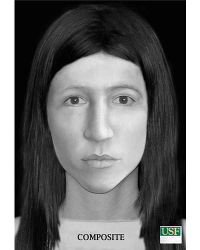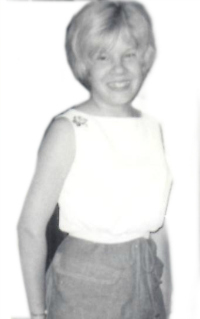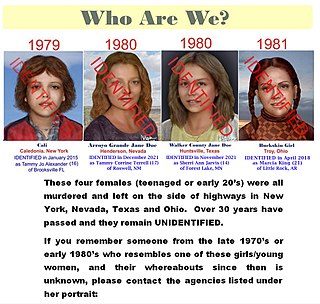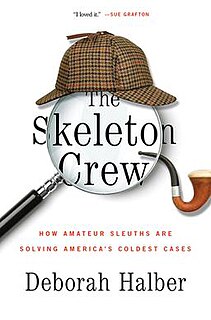
Barbara Ann "Bobbie" Hackmann Taylor, also known as the "Tent Girl", was notable as an unidentified homicide victim for nearly 30 years after her body was found on May 17, 1968, near Georgetown, Kentucky. She was referred to as "Tent Girl" because of the material wrapped around her. On April 23, 1998, the Scott County Sheriff's Office announced that this victim had been identified. Hackmann Taylor, born in Illinois, was married and had an eight-month-old daughter when she went missing from her home in Lexington, Kentucky.

Ruth Marie Terry, also known as Lady of the Dunes, was a formerly unidentified decedent found on July 26, 1974, in the Race Point Dunes in Provincetown, Massachusetts. Her body was exhumed in 1980, 2000, and 2013 in efforts to identify her killer.

Little Miss Lake Panasoffkee, or Little Miss Panasoffkee, is the name given to an unidentified young woman found murdered on February 19, 1971, in Lake Panasoffkee, Florida, United States. She has remained unidentified for 51 years.

Marcia Lenore Sossoman (King) was a 21-year-old Arkansas woman who was murdered in April 1981 and whose body was discovered in Troy, Ohio approximately 48 hours after her murder. Her body remained unidentified for 36 years before being identified via DNA analysis and genetic genealogy in April 2018. King was one of the first unidentified decedents to be identified via this method of forensic investigation.

Evelyn Colon was a formerly unidentified American teenager from New Jersey who was found murdered and dismembered in three suitcases along with her unborn daughter on December 20, 1976, in White Haven, Pennsylvania. The brutality of the crime, the fact that she was pregnant when she was killed and the length of time that she remained unidentified created national attention. After isotope analysis was conducted in 2007, it was believed she had been an immigrant from a Central European country. In 2019, it was announced police were considering the possibility that this victim had been a runaway foster child who was last known to be in New York, but investigators subsequently located the girl and confirmed that she was alive.

Sherri Ann Jarvis was an American murder victim from Forest Lake, Minnesota whose body was discovered in Huntsville, Texas on November 1, 1980. Her body was discovered within hours of her sexual assault and murder, and remained unidentified for 41 years before investigators announced her identification via forensic genealogy in November 2021.

Tammy Corrine Terrell was an American murder victim from Roswell, New Mexico. Her body was discovered on October 5, 1980, in Henderson, Nevada, and remained unidentified until December 2021. Her case has been the subject of extensive efforts by investigators and has been highlighted as inspiring other work to solve cold cases of unidentified murder victims.

Dana Lynn Dodd was a formerly unidentified American murder victim whose body was found in 2006 in Kilgore, Texas. In 2013, investigators had hoped that a new reconstruction of the victim might uncover more leads. In August 2018, Joseph Wayne Burnette was indicted for her murder, following a confession, stating her name may have been "Ashley." The victim's case was later submitted to the DNA Doe Project, who made an identification in January 2019, 12 years later. While she remained unidentified, she was known by the nickname "Lavender Doe".

Marilee Lee Bruszer, previously known as Juab County Jane Doe, was a formerly unidentified American murder victim who was found on September 3, 1978. Bruszer's body was not identified for 37 years due to an inaccurate physical description generated by the original investigators and the great distance she was found from where she had resided prior to her disappearance.

Tempe Girl is the name given to an unidentified decedent whose body was discovered on April 27, 2002 in Tempe, Arizona. She had died of cocaine intoxication—ruled to be neither an accident nor a homicide—one day before the discovery of her body. This decedent is believed to have been of either Hispanic or Native American ethnicity and was allegedly picked up while hitchhiking, claiming she had been effectively disowned by her own mother for her frequent recreational drug use.

Unidentified decedent or unidentified person is a term in American English used to describe a corpse of a person whose identity cannot be established by police and medical examiners. In many cases, it is several years before the identities of some UIDs are found, while in some cases, they are never identified. A UID may remain unidentified due to lack of evidence as well as absence of personal identification such as a driver's license. Where the remains have deteriorated or been mutilated to the point that the body is not easily recognized, a UID's face may be reconstructed to show what they had looked like before death. UIDs are often referred to by the placeholder names "John Doe" or "Jane Doe".

The Skeleton Crew: How Amateur Sleuths Are Solving America's Coldest Cases is a 2014 non-fiction work that was written by Deborah Halber. It was first published on 1 July 2014 by Simon & Schuster and details the phenomenon of citizens creating and using Internet resources to identify unidentified human remains.
The Redhead murders is the media epithet used to refer to a series of unsolved homicides of redheaded females in the United States between October 1978 and 1992, believed to have been committed by an unidentified male serial killer. The murders believed to be related have occurred in states including Tennessee, Arkansas, Kentucky, Mississippi, Pennsylvania, and West Virginia. The murders may have continued until 1992. The victims, many remaining unidentified for years, were usually women with reddish hair, whose bodies were abandoned along major highways in the United States. Officials believe that the women were likely hitchhiking or may have engaged in sex work.

Alisha Ann Heinrich, previously known as "Baby Jane" and "Delta Dawn", was a formerly unidentified American child murder victim whose body was found in Moss Point, Mississippi, in December 1982. The child — aged approximately 18 months — was partially smothered before she was thrown alive from the eastbound Interstate 10 bridge into the Escatawpa River, where she ultimately drowned. Her body was recovered between 36 and 48 hours after her death.

April Dawn Lacy was a previously unidentified American homicide victim who was discovered in 1996 in Decatur, Texas. She was identified in 1998 after her face was reconstructed and dental information was compared between both subjects. Although her body was identified, her murder remains unsolved. The circumstances surrounding April's murder are unknown, although she is believed by police to have run away from home and may have engaged in prostitution.

Deanna Lee Criswell was an American girl from Washington state who was murdered by firearm at age 16 and remained unidentified for 27 years. Criswell's body was found on November 25, 1987 in Marana, Arizona, near Tucson. The Marana Police Department announced her identification on February 11, 2015, aided by the sophisticated technology of forensic facial reconstruction and DNA analysis, and by websites set up by amateurs to help identify missing and unidentified persons.

David Arthur Stack was an American man who was murdered while hitchhiking from his home in Broomfield, Colorado to California. Stack was murdered by an unknown assailant or assailants in Wendover, Utah. His body was found approximately one day after his murder in a landfill in rural Tooele County, although he remained an unidentified decedent for 39 years until 2015 when his body was identified via a comparison of both dental records and genetic testing.

DNA Doe Project is an American non-profit volunteer organization formed to identify unidentified deceased persons using forensic genealogy. Volunteers identify victims of automobile accidents, homicide, and unusual circumstances, and persons who committed suicide under an alias. The group was founded in 2017 by Colleen Fitzpatrick and Margaret Press.

















